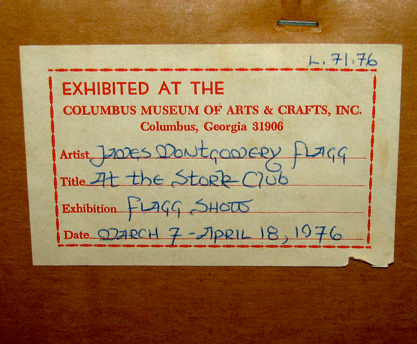 |
| Above: Detail |
 |
| Above: Detail |
 |
| Above: The artist’s signature lower left |
A large, signed, oil on canvas painting by prolific and influential New York City illustrator James Montgomery Flagg titled “At The Stork Club.” A prohibition/speakeasy-era, exhibited, large format illustration inviting us in behind the doors of New York City’s legendary Stork Club. Exhibited in 1976 at the Columbus Museum of Arts and Crafts in Columbus Georgia as well as the Berry-Hill Galleries on 5th Avenue in New York.
 |
| Above: Full view |
 |
| Above: Detail |
Flagg was outspoken and lived a bohemian style of life. Despite a marriage that lasted from 1899 until his wife’s death in 1923, he was known for his cavorting around town with pals like John Barrymore. He was close friends with many of his contemporaries: Arthur William Brown, Walter Appleton Clark, Ham Fisher, Rube Goldberg, etc. Flagg was a founder member of the infamous Dutch Treat Club in 1906 (its president in 1913), a loose association of creative types that turned into an organization still going strong today.
He wrote the first of their annual productions and was elected an honorary life member in 1926. By then he’d dropped out of active participation, but when the Depression hit and the club loosened up, he was back. He began to contribute artwork to the wonderful annuals that were distributed at the yearly dinners.It seems that the more bawdy and risque and boisterous the organization became, the more Flagg wanted to be a part of it.
 |
| Above: Exhibit labels |
 |
| Above: Berry-Hill Galleries label |
 |
| Above: Museum Show Label C. 1976 – Columbus Georgia |
 |
| Above: Verso view of canvas and stretchers |
James Montgomery Flagg (June 18, 1877 — May 27, 1960) was an American artist and illustrator. He worked in media ranging from fine art painting to cartooning, but is best remembered for his Military propaganda posters with his iconic Uncle Sam proclaiming “I Want You”.
Flagg was born in Pelham Manor, New York. He was enthusiastic about drawing from a young age, and had illustrations accepted by national magazines by the age of 12 years. By 14 he was a contributing artist for Life magazine, and the following year was on the staff of another magazine, Judge. From 1894 through 1898, he attended the Art Students League of New York. He studied fine art in London and Paris from 1898—1900, after which he returned to the United States, where he produced countless illustrations for books, magazine covers, political and humorous cartoons, advertising, and spot drawings. Among his creations was a comic strip that appeared regularly in Judge from 1903 until 1907, about a tramp character titled Nervy Nat.
His most famous poster was created in 1917 to encourage recruitment in the United States Army during World War I. It showed Uncle Sam pointing at the viewer (inspired by a British recruitment poster showing Lord Kitchener in a similar pose) with the caption “I Want You for U.S. Army”. Over four million copies of the poster were printed during World War I, and it was revived for World War II. Flagg used his own face for that of Uncle Sam (adding age and the white goatee), he said later, simply to avoid the trouble of arranging for a model.
At his peak, Flagg was reported to have been the highest paid magazine illustrator in America. In 1946 Flagg published his autobiography, Roses and Buckshot.
James Montgomery Flagg died in New York City and was interred at Woodlawn Cemetery.
